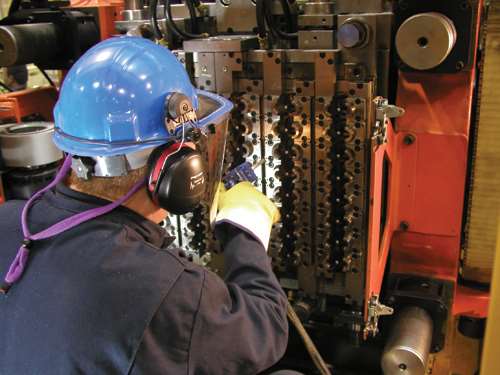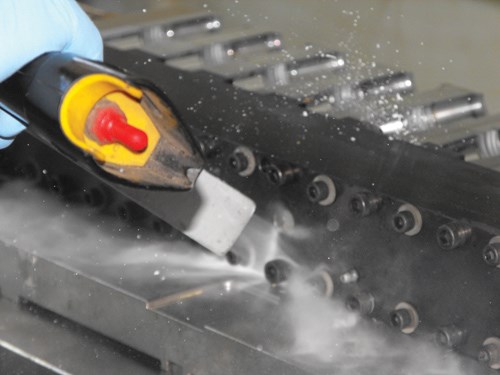Going for the Green
One of the biggest stars in Augusta, GA, during a recent golf week wasn't named Tiger or Phil, but rather E-Z-GO, one of the top manufacturers of golf carts and utility vehicles.Officials and VIPs zipped around the course in E-Z-GO vehicles to service the throngs of patrons who come out to watch the game's most famous tournament.
#automotive
One of the biggest stars in Augusta, GA, during a recent golf week wasn't named Tiger or Phil, but rather E-Z-GO, one of the top manufacturers of golf carts and utility vehicles.
Officials and VIPs zipped around the course in E-Z-GO vehicles to service the throngs of patrons who come out to watch the game's most famous tournament. What they didn't see was the new zinc phosphate free anti-corrosion pretreatment that enhanced the paint performance on E-Z-GO's line of vehicles to keep them durable for many golf rounds to come.
Featured Content
E-Z-GO switched recently to Chemetall's Oxsilan, an advanced pretreatment that replaced the traditional iron and zinc phosphate products it had been using. Besides the ecological improvements, Oxsilan is bringing E-Z-GO the added benefits of lower operating costs and quicker processing times.
"We've definitely saved some money, and received just as good salt spray results as we had before," says Gibson Packard, Manufacturing Engineering Manager for E-Z-GO, which is part of Textron, a multi-industry company, and home to various market-leading companies in aircraft, manufacturing and finance, including brands such as Cessna Aircraft, Bell Helicopter, Kautex, Cushman, Jacobsen, Lycoming and Greenlee.
"The biggest surprise has been in water savings," Packard says. "We knew we would see some savings in our processes, but there has been a drastic improvement in water consumption to the tune of about 30%, plus we're dealing with chemicals that are friendlier to the environment."
Chemetall US, Inc officials say this is what they expected when they introduced the product a few years ago to perform on steel, iron, aluminum and zinc substrates. It is used at ambient temperature by spray or immersion, and it is made with both organic and inorganic components.
"Our customers are realizing a significant cost savings since activation and final seals are not required," says Gary Nelson, Chemetall's product manager for surface treatment.
"Energy and maintenance costs are kept to a minimum, and shorter treatment times allow for improved process efficiencies."
Chris Keeter, a Chemetall technical sales specialist who works closely with E-Z-GO, says bath concentration is controlled by pH and titration measurement, thus requiring less maintenance.
Nelson says that the Oxsilan process is distinguished by having both organic and inorganic components. The organic component is a silane made of a silicon atom combined with an organic molecule. For pretreatments, organofunctional silanes are used to form very stable bonds with the metal hydroxides on the substrate, as well as the organic groups on the paint resins. Nelson says that when these organofunctional silanes are reacted with water in the manufacturing facility, they will then form polycondensates that keep the paint and metal-bonding properties of the silane, although in an easy-to-use form. As the silane film dries on the pretreated substrate, nearby hydroxyl groups on the silane molecule react with each other to form a dense, cross-linked covering.
Nelson says the inorganic components are non-regulated group IV-B metals -- such as zirconium -- which bond to the metal substrate, providing better corrosion-resistance compared to a silane-only process.
"In effect, a dual coating is formed in one step," Nelson says. "An inorganic coating comprised of zirconium and other non-regulated metals, and an organofunctional silane coating."
Keeter says that Chemetall began developing Oxsilan several years ago in response to new legislative demands on its customer, and to meet strict industry standards for quality and safety. Sludge is virtually eliminated, and further efficiencies are gained through the ease of wastewater treatment and the minimization of wastewater by utilizing a counterflowing rinse system.
That is one reason Packard was attracted to Oxsilan. "We had been thinking for some time about making the switch because it's obvious that zinc is going to hit the 'attention list' of the EPA very soon," he says. "We were just trying to stay ahead of that curve, and Chemetall has been very good at being aggressive in solving the environmental issues that most manufacturers have."
Nelson explained that Oxsilan is based on functionalized organo-silane polymers that react at room temperature with hydroxides present in the metal oxide layer of cleaned metal substrates, which allows it to form stronger covalent bonds with the metal substrate.
Process time is reduced from two to three minutes to just one, and Nelson says Oxsilan's process efficiencies also reduce heating and electrical costs by 30 percent over using zinc phosphate.
"Our big concern with switching to a silane product was with the level of concentration we needed to maintain in order to get a good coating and achieve the corrosion protection we wanted," Packard says. "Our estimates were conservative, but we got even better results than we expected. We matched our zinc results, so any time you can save some money and not have to take a step back in quality, that's a good thing."
E-Z-GO has two assembly lines running daily, each producing about 300 vehicles. Consistency in the application processes was crucial, Packard says. "We push a lot of metal through here every day, and since we are automated, you want something that will continue to run with the line," he says. "Oxsilan is a very stable process, and we're happy with that."
Packard says the wear and tear subjected to E-Z-GO products is just as tough as anything Detroit produces, if not more. "A golf cart operates in a pretty aggressive environment nearly all the time," he says. "It gets wet on the underside nearly every single day because of the morning dew, and then you have fertilizers, insecticides and other chemicals wetting the cart, plus the coastal areas add the constant salt exposure. It's an aggressive environment year round for these vehicles."
RELATED CONTENT
-
The 2024 Ford Mustang: All the Colors Available
Although Chevrolet has announced the end of the Camaro and Dodge is offering “Last Call” editions of the Charger and Challenger, the Ford Mustang is launching to its seventh generation.
-
Corrosion Testing of Automotive Coatings
Exposure to road salts, UV radiation, heat, moisture and chipping from kicked-up road debris can quickly degrade an automotive coating system.
-
Building an E-coat Line from the Ground Up
How one company is prospering by providing flexible e-coat capability to Nissan and other customers.




















